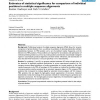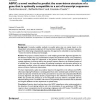291 search results - page 12 / 59 » Progressive multiple sequence alignments from triplets |
BMCBI
2005
13 years 7 months ago
2005
Background: Pairwise stochastic context-free grammars (Pair SCFGs) are powerful tools for evolutionary analysis of RNA, including simultaneous RNA sequence alignment and secondary...
BMCBI
2004
13 years 7 months ago
2004
Background: Profile-based analysis of multiple sequence alignments (MSA) allows for accurate comparison of protein families. Here, we address the problems of detecting statistical...
BMCBI
2007
13 years 7 months ago
2007
Background: By virtue of their shared ancestry, homologous sequences are similar in their structure and function. Consequently, multiple sequence alignments are routinely used to ...
BMCBI
2005
13 years 7 months ago
2005
Background: Currently available methods to predict splice sites are mainly based on the independent and progressive alignment of transcript data (mostly ESTs) to the genomic seque...
NAR
1998
13 years 7 months ago
1998
Pfam contains multiple alignments and hidden Markov model based profiles (HMM-profiles) of complete protein domains. The definition of domain boundaries, family members and alignm...


